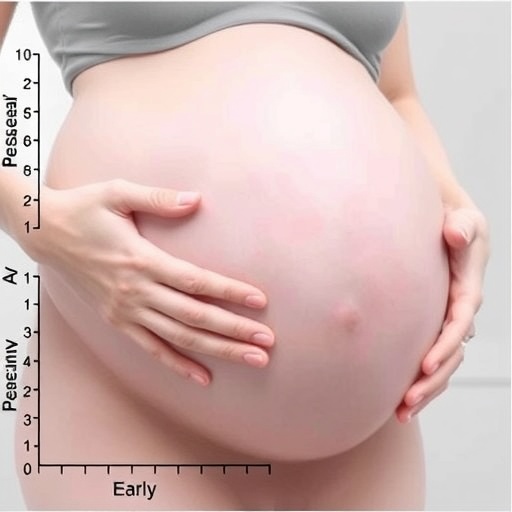In an unprecedented leap forward in prenatal care, researchers have unveiled groundbreaking work on using maternal plasma cell-free RNA as an innovative method to predict early and late-onset preeclampsia throughout pregnancy. This pioneering study, published in Nature Communications, opens a new frontier in obstetric medicine, offering hope for millions of expectant mothers worldwide who remain at risk of this potentially life-threatening condition.
Preeclampsia, a complex hypertensive disorder that typically develops after the 20th week of gestation, has remained a significant challenge in maternal-fetal health. Characterized by high blood pressure and damage to organ systems, particularly the liver and kidneys, preeclampsia not only endangers the mother but also poses severe risks to fetal development and survival. Despite extensive research, early prediction and intervention have been elusive, making this recent advancement a beacon of promise.
The key to this breakthrough lies in the sophisticated analysis of cell-free RNA (cfRNA) circulating in the maternal bloodstream. Unlike traditional diagnostic methods that rely upon clinical observations and biochemical markers, cfRNA profiling offers a non-invasive molecular snapshot of both maternal and placental health. Cell-free RNA molecules are fragments of genetic material shed by cells, representing active biological processes and enabling dynamic monitoring of physiological changes throughout pregnancy.
This longitudinal study meticulously tracked cfRNA patterns from numerous pregnant participants, charting the molecular shifts across various gestational stages. By integrating high-throughput sequencing technologies with advanced bioinformatic algorithms, the researchers successfully identified distinct RNA expression signatures that correlate with the onset of preeclampsia, distinguishing both early-onset and late-onset forms, which differ in timing and severity.
The most compelling aspect of this research is its ability to detect these transcriptomic changes well before clinical symptoms emerge. The early-onset variant, often associated with severe maternal and fetal complications, was indicated by specific upregulated RNA transcripts as early as the first trimester in the study cohort. This unprecedented early detection window could revolutionize prenatal care protocols by enabling clinicians to initiate preventive measures or closer monitoring, thereby averting adverse outcomes.
Moreover, the late-onset preeclampsia, typically less severe but still impactful, exhibited a distinct RNA expression profile that became evident during the second trimester. The dual predictive capacity for these phenotypically different yet clinically significant forms of preeclampsia underscores the robustness of cfRNA as an integrated biomarker system. By capturing dynamic gene expression reflective of placental function and maternal immune status, cfRNA profiling provides a holistic molecular readout of pregnancy health.
Technically, the researchers utilized plasma samples collected longitudinally, employing rigorous extraction and purification protocols to enrich for cfRNA. They harnessed state-of-the-art next-generation sequencing to generate comprehensive transcriptomic datasets, followed by machine learning models trained to classify preeclampsia risk states with remarkable accuracy. This innovative combination of molecular biology and computational analytics exemplifies the cutting-edge nature of modern biomedical research.
In addition to predictive accuracy, the study shed light on the underlying pathophysiological mechanisms of preeclampsia. The disrupted expression of genes involved in angiogenesis, immune modulation, and oxidative stress pathways detected in cfRNA profiles align with established pathogenetic theories. This molecular insight not only corroborates prior knowledge but also identifies novel candidate pathways that could be leveraged for therapeutic development, potentially catalyzing drug discovery aimed at mitigating or preventing disease progression.
The implications for clinical translation are profound. A minimally invasive, blood-based test harnessing cfRNA as a biomarker could be seamlessly integrated into routine prenatal screening regimes. Such a test promises to stratify risk early, personalize maternal care with targeted surveillance, and ultimately reduce the incidence of severe complications such as eclampsia, renal failure, and preterm birth associated with preeclampsia.
Public health impact cannot be overstated, given the global prevalence of preeclampsia and its contribution to maternal and neonatal morbidity and mortality, especially in low-resource settings where diagnostic infrastructure is limited. The scalability and accessibility potential of cfRNA-based assays make them particularly attractive for widespread adoption, democratizing advanced prenatal diagnostics across diverse healthcare environments.
Nonetheless, the research team acknowledges that translational hurdles remain. Large-scale validation studies across ethnically diverse populations are necessary to ascertain the generalizability of the cfRNA signatures. Furthermore, standardization of sample collection, processing parameters, and computational frameworks will be essential to ensure reproducibility and regulatory approval for clinical implementation.
This landmark study signals a paradigm shift toward precision obstetrics, where molecular diagnostics move beyond retrospective clinical signs to preemptive detection and personalized intervention. It underscores the value of integrating multi-omics data with artificial intelligence to unravel the complexities of maternal-fetal interactions and enhance pregnancy outcomes.
The road ahead is exciting yet demands collaboration among clinicians, researchers, and industry stakeholders to translate these findings into accessible, reliable, and cost-effective tests. As the technology matures, cfRNA profiling might become a staple of prenatal care, reflecting a new era of molecular medicine that safeguards mothers and babies from the devastating impacts of preeclampsia.
In essence, this research not only enriches the understanding of preeclampsia pathobiology but also exemplifies the transformative potential of liquid biopsy approaches in maternal health. By illuminating the hidden transcriptomic signals within maternal plasma, scientists are now better equipped to battle a condition that has long defied early detection and effective management.
The promise of this work extends beyond preeclampsia alone. It opens avenues for exploring cfRNA-based diagnostics for a spectrum of pregnancy-related disorders, from fetal growth restriction to gestational diabetes, thereby forging a comprehensive molecular toolkit for monitoring maternal-fetal well-being throughout gestation.
As this research gains traction and inspires further innovation, pregnant individuals stand to benefit from a new standard of care driven by precision, sensitivity, and proactive management. The fusion of molecular biology with clinical medicine heralds a future where maternal and neonatal health can be preserved with unprecedented efficacy.
The findings highlight the immense value of translational research at the intersection of genomics, obstetrics, and computational science. They serve as a compelling testament to how cutting-edge technologies can resolve longstanding clinical dilemmas and improve human health on a global scale.
Ultimately, the integration of maternal plasma cfRNA profiling into prenatal diagnostics represents a monumental leap forward, paving the way for early, accurate, and actionable insights into one of pregnancy’s most formidable complications. This milestone is poised to redefine the landscape of maternal-fetal medicine and inspire hope for safer pregnancies worldwide.
Subject of Research: Maternal plasma cell-free RNA as a predictive biomarker for early and late-onset preeclampsia throughout pregnancy
Article Title: Maternal plasma cell-free RNA as a predictor of early and late-onset preeclampsia throughout pregnancy
Article References:
Castillo-Marco, N., Cordero, T., Igual, M. et al. Maternal plasma cell-free RNA as a predictor of early and late-onset preeclampsia throughout pregnancy. Nat Commun 16, 9208 (2025). https://doi.org/10.1038/s41467-025-64215-2
Image Credits: AI Generated
Tags: biochemical markers for preeclampsiaearly prediction of preeclampsiahypertensive disorders in pregnancylate-onset preeclampsiamaternal cell-free RNAmaternal-fetal health innovationsNature Communications study on preeclampsianon-invasive pregnancy diagnosticspredictive biomarkers in maternal healthprenatal care advancementsrisks of preeclampsia on fetal developmentRNA profiling in obstetrics





